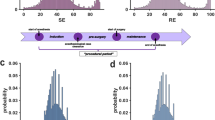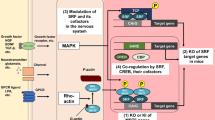Abstract
Neonatal exposure to volatile anesthetics causes apoptotic neurodegeneration in the developing brain, possibly leading to neurocognitive deficits in adulthood. Endoplasmic reticulum (ER) stress might be associated with sevoflurane (sevo)-induced neuroapoptosis. However, the signaling pathway regulating sevo-induced neuroapoptosis is not understood. We investigated the effects of neonatal sevo exposure on ER signaling pathway activation. Seven-day-old mouse pups were divided into control (C) and sevo (S; 3 % sevo exposure, 6 h) groups. ER stress marker [protein kinase RNA-like ER kinase (PERK), eukaryotic translation initiation factor 2α (eIF2α), activating transcription factor 4 (ATF4), CHOP, and caspase-12] levels were determined by western blotting. To understand the role of eIF2α in sevo-induced ER stress and caspase-3 activation, pups were pretreated with an eIF2α dephosphorylation inhibitor, salubrinal, and a potent and selective inhibitor of PERK, GSK2656157, before sevo exposure, and the effects on ER stress signaling and neuroapoptosis were examined. We investigated whether neonatal exposure to sevo increased β-site APP-cleaving enzyme 1 (BACE-1) expression. Neonatal sevo exposure elevated caspase-3 activation. ER stress signaling was activated, along with increased PERK and eIF2α phosphorylation, and upregulation of proapoptotic proteins (ATF4 and CHOP) in the cerebral cortex of the developing brain. Pretreatment with salubrinal augmented sevo-induced eIF2α phosphorylation, which inhibited ER stress-mediated ATF4 and caspase-3 activation. Inhibition of PERK phosphorylation due to GSK2656157 pretreatment reduced the sevo-induced increase in eIF2α phosphorylation. Sevo increased BACE-1 expression, which was attenuated by GSK2656157 and salubrinal pretreatment. Our data suggested that neonatal sevo exposure-induced neuroapoptosis is mediated via the PERK-eIF2α-ATF4-CHOP axis of the ER stress signaling pathway. Modulation of eIF2α phosphorylation may play a key role in sevo-induced neurotoxicity in the developing brain.








Similar content being viewed by others
References
Blaylock M, Engelhardt T, Bissonnette B (2010) Fundamentals of neuronal apoptosis relevant to pediatric anesthesia. Paediatr Anaesth 20(5):383–395
Boyce M, Bryant KF, Jousse C, Long K, Harding HP, Scheuner D, Kaufman RJ, Ma D, Coen DM, Ron D, Yuan J (2005) A selective inhibitor of eIF2alpha dephosphorylation protects cells from ER stress. Science 307:935–939
Chen G, Gong M, Yan M, Zhang X (2013) Sevoflurane induces endoplasmic reticulum stress mediated apoptosis in hippocampal neurons of aging rats. PLoS One 8(2):e57870
Chung W, Park S, Hong J, Park S, Lee S, Heo J, Kim D, Ko Y (2015) Sevoflurane exposure during the neonatal period induces long-term memory impairment but not autism-like behaviors. Paediatr Anaesth 25:1033–1045
Devi L, Ohno M (2014) PERK mediates eIF2α phosphorylation responsible for BACE1 elevation, CREB dysfunction and neurodegeneration in a mouse model of Alzheimer’s disease. Neurobiol Aging 35(10):2272–2281
Doyle KM, Kennedy D, Gorman AM, Gupta S, Healy SJ, Samali A (2011) Unfolded proteins and endoplasmic reticulum stress in neurodegenerative disorders. J Cell Mol Med 15(10):2025–2039
Duan Z, Zhao J, Fan X, Tang C, Liang L, Nie X, Liu J, Wu Q, Xu G (2014) The PERK-eIF2α signaling pathway is involved in TCDD-induced ER stress in PC12 cells. Neurotoxicology 44:149–159
Gao B, Zhang XY, Han R, Zhang TT, Chen C, Qin ZH, Sheng R (2013) The endoplasmic reticulum stress inhibitor salubrinal inhibits the activation of autophagy and neuroprotection induced by brain ischemic preconditioning. Acta Pharmacol Sin 34(5):657–666
Ge HW, Hu WW, Ma LL, Kong FJ (2015) Endoplasmic reticulum stress pathway mediates isoflurane-induced neuroapoptosis and cognitive impairments in aged rats. Physiol Behav 151:16–23
Goswami P, Gupta S, Biswas J, Joshi N, Swarnkar S, Nath C, Singh S (2016) Endoplasmic reticulum stress plays a key role in rotenone-induced apoptotic death of neurons. Mol Neurobiol 53(1):285–298
Ishizeki J, Nishikawa K, Kubo K, Saito S, Goto F (2008) Amnestic concentrations of sevoflurane inhibit synaptic plasticity of hippocampal CA1 neurons through gamma-aminobutyric acid-mediated mechanisms. Anesthesiology 108(3):447–456
Jevtovic-Todorovic V, Hartman RE, Izumi Y, Benshoff ND, Dikranian K, Zorumski CF, Olney JW, Wozniak DF (2003) Early exposure to common anesthetic agents causes widespread neurodegeneration in the developing rat brain and persistent learning deficits. J Neurosci 23(3):876–882
Jiang Z, Belforte JE, Lu Y, Yabe Y, Pickel J, Smith CB, Je HS, Lu B, Nakazawa K (2010) eIF2alpha phosphorylation-dependent translation in CA1 pyramidal cells impairs hippocampal memory consolidation without affecting general translation. J Neurosci 30(7):2582–2594
Ke Z, Wang X, Liu Y, Fan Z, Chen G, Xu M, Bower KA, Frank JA, Li M, Fang S, Shi X, Luo J (2011) Ethanol induces endoplasmic reticulum stress in the developing brain. Alcohol Clin Exp Res 35(9):1574–1583
Koizumi M, Tanjung NG, Chen A, Dynlacht JR, Garrett J, Yoshioka Y, Ogawa K, Teshima T, Yokota H (2012) Administration of salubrinal enhances radiation-induced cell death of SW1353 chondrosarcoma cells. Anticancer Res 32(9):3667–3673
Komita M, Jin H, Aoe T (2013) The effect of endoplasmic reticulum stress on neurotoxicity caused by inhaled anesthetics. Anesth Analg 117(5):1197–1204
Krishnamoorthy J, Rajesh K, Mirzajani F, Kesoglidou P, Papadakis AI, Koromilas AE (2014) Evidence for eIF2α phosphorylation-independent effects of GSK2656157, a novel catalytic inhibitor of PERK with clinical implications. Cell Cycle 13(5):801–806
Lee DY, Lee K-S, Lee HJ, Kim DH, Noh YH et al (2010) Activation of PERK signaling attenuates Ab-mediated ER stress. PLoS One 5(5):e10489
Liu B, Gu Y, Xiao H, Lei X, Liang W, Zhang J (2015) Altered metabolomic profiles may be associated with sevoflurane-induced neurotoxicity in neonatal rats. Neurochem Res 40(4):788–799
Ma T, Trinh MA, Wexler AJ, Bourbon C, Gatti E, Pierre P, Cavener DR, Klann E (2013) Suppression of eIF2a kinases alleviates Alzheimer’s disease related plasticity and memory deficits. Nat Neurosci 16(9):1299–1305
Mandl J, Mészáros T, Bánhegyi G, Csala M (2013) Minireview: endoplasmic reticulum stress: control in protein, lipid, and signal homeostasis. Mol Endocrinol 27(3):384–393
Matsuoka M, Komoike Y (2015) Experimental evidence shows salubrinal, an eIF2α dephosphorylation inhibitor, reduces xenotoxicant-induced cellular damage. Int J Mol Sci 16(7):16275–16287
Mouton-Liger F, Paquet C, Dumurgier J, Bouras C, Pradier L, Gray F, Hugon J (2012) Oxidative stress increases BACE1 protein levels through activation of the PKR-eIF2α pathway. Biochim Biophys Acta 1822(6):885–896
O’Connor T, Sadleir KR, Maus E, Velliquette RA, Zhao J, Cole SL, Eimer WA, Hitt B, Bembinster LA, Lammich S, Lichtenthaler SF, Hébert SS, De Strooper B, Haass C, Bennett DA, Vassar R (2008) Phosphorylation of the translation initiation factor eIF2alpha increases BACE1 levels and promotes amyloidogenesis. Neuron 60(6):988–1009
Paschen W (2003) Endoplasmic reticulum: a primary target in various acute disorders and degenerative diseases of the brain. Cell Calcium 34(4–5):365–383
Peng J, Drobish JK, Liang G, Wu Z, Liu C, Joseph DJ, Abdou H, Eckenhoff MF, Wei H (2014) Anesthetic preconditioning inhibits isoflurane-mediated apoptosis in the developing rat brain. Anesth Analg 119(4):939–946
Roussel BD, Kruppa AJ, Miranda E, Crowther DC, Lomas DA, Marciniak SJ (2013) Endoplasmic reticulum dysfunction in neurological disease. Lancet Neurol 12(1):105–118
Sadleir KR, Eimer WA, Kaufman RJ, Osten P, Vassar R (2014) Genetic inhibition of phosphorylation of the translation initiation factor eIF2α does not block Aβ-dependent elevation of BACE1 and APP levels or reduce amyloid pathology in a mouse model of Alzheimer’s disease. PLoS One 9(7):e101643
Satomoto M, Satoh Y, Terui K, Miyao H, Takishima K, Ito M, Imaki J (2009) Neonatal exposure to sevoflurane induces abnormal social behaviors and deficits in fear conditioning in mice. Anesthesiology 110(3):628–637
Scheuner D, Song B, McEwen E, Liu C, Laybutt R, Gillespie P, Saunders T, Bonner-Weir S, Kaufman RJ (2001) Translational control is required for the unfolded protein response and in vivo glucose homeostasis. Mol Cell 7:1165–1176
Scheuner D, Patel R, Wang F, Lee K, Kumar K, Wu J, Nilsson A, Karin M, Kaufman RJ (2006) Double-stranded RNA-dependent protein kinase phosphorylation of the alpha-subunit of eukaryotic translation initiation factor 2 mediates apoptosis. J Biol Chem 281(30):21458–21468
Shen X, Dong Y, Xu Z, Wang H, Miao C, Soriano SG, Sun D, Baxter MG, Zhang Y, Xie Z (2013) Selective anesthesia-induced neuroinflammation in developing mouse brain and cognitive impairment. Anesthesiology 118(3):502–515
Srivastava SP, Kumar KU, Kaufman RJ (1998) Phosphorylation of eukaryotic translation initiation factor 2 mediates apoptosis in response to activation of the double-stranded RNA-dependent protein kinase. J Biol Chem 273(4):2416–2423
Stefani IC, Wright D, Polizzi KM, Kontoravdi C (2012) The role of ER stress-induced apoptosis in neurodegeneration. Curr Alzheimer Res 9(3):373–387
Teng Y, Gao M, Wang J, Kong Q, Hua H, Luo T, Jiang Y (2014) Inhibition of eIF2α dephosphorylation enhances TRAIL-induced apoptosis in hepatoma cells. Cell Death Dis 5:e1060
Velliquette RA, O’Connor T, Vassar R (2005) Energy inhibition elevates beta-secretase levels and activity and is potentially amyloidogenic in APP transgenic mice: possible early events in Alzheimer’s disease pathogenesis. J Neurosci 25(47):10874–10883
Verfaillie T, Rubio N, Garg AD, Bultynck G, Rizzuto R, Decuypere J-P, Piette J, Linehan C, Gupta S, Samali A, Agostinis P (2012) PERK is required at the ER-mitochondrial contact sites to convey apoptosis after ROS-based ER stress. Cell Death Differ 19(11):1880–1891
Wang H, Dong Y, Zhang J, Xu Z, Wang G, Swain CA, Zhang Y, Xie Z (2014a) Isoflurane induces endoplasmic reticulum stress and caspase activation through ryanodine receptors. Br J Anaesth 113(4):695–707
Wang Q, Zhao Y, Sun M, Liu S, Li B, Zhang L, Yang L (2014b) 2-Deoxy-d-glucose attenuates sevoflurane-induced neuroinflammation through nuclear factor-kappa B pathway in vitro. Toxicol In Vitro 28(7):1183–1189
Wei H, Liang G, Yang H, Wang Q, Hawkins B, Madesh M, Wang S, Eckenhoff RG (2008) The common inhalational anesthetic isoflurane induces apoptosis via activation of inositol 1,4,5-trisphosphate receptors. Anesthesiology 108(2):251–260
Xu C, Bailly-Maitre B, Reed JC (2005) Endoplasmic reticulum stress: cell life and death decisions. J Clin Investig 115(10):2656–2664
Xue X, Piao JH, Nakajima A, Sakon-Komazawa S, Kojima Y, Mori K, Yagita H, Okumura K, Harding H, Nakano H (2005) Tumor necrosis factor alpha (TNFalpha) induces the unfolded protein response (UPR) in a reactive oxygen species (ROS)-dependent fashion, and the UPR counteracts ROS accumulation by TNFalpha. J Biol Chem 280(40):33917–33925
Yi W, Zhang Y, Guo Y, Li D, Li X (2015) Elevation of Sestrin-2 expression attenuates Sevoflurane induced neurotoxicity. Metab Brain Dis 30(5):1161–1166
Yon JH, Daniel-Johnson J, Carter LB, Jevtovic-Todorovic V (2005) Anesthesia induces neuronal cell death in the developing rat brain via the intrinsic and extrinsic apoptotic pathways. Neuroscience 135(3):815–827
Yon JH, Carter LB, Reiter RJ, Jevtovic-Todorovic V (2006) Melatonin reduces the severity of anesthesia-induced apoptotic neurodegeneration in the developing rat brain. Neurobiol Dis 21:522–530
Zhang Y, Xu Z, Wang H, Dong Y, Shi HN, Culley DJ, Crosby G, Marcantonio ER, Tanzi RE, Xie Z (2012) Anesthetics isoflurane and desflurane differently affect mitochondrial function, learning, and memory. Ann Neurol 71(5):687–698
Acknowledgments
We are very grateful to Professor Jianhai Jiang from the Department of Biochemistry, School of Medicine, Fudan University for his technical assistance. This work was supported by Grant (No. 14-E28) from the Science and Technology Committee of Shanghai Baoshan District (to Jun Zhang).
Author Contributions
Bin Liu performed experiments and statistical analysis. Junming Xia performed experiments and statistical analysis. Yali Chen performed experiments. Jun Zhang study design and manuscript preparation.
Author information
Authors and Affiliations
Corresponding author
Ethics declarations
Conflicts of interest
Bin Liu, Junming Xia, Yali Chen, and Jun Zhang have reported no conflicts of interest.
Additional information
Bin Liu and Junming Xia share equal contributions to this study.
Rights and permissions
About this article
Cite this article
Liu, B., Xia, J., Chen, Y. et al. Sevoflurane-Induced Endoplasmic Reticulum Stress Contributes to Neuroapoptosis and BACE-1 Expression in the Developing Brain: The Role of eIF2α. Neurotox Res 31, 218–229 (2017). https://doi.org/10.1007/s12640-016-9671-z
Received:
Revised:
Accepted:
Published:
Issue Date:
DOI: https://doi.org/10.1007/s12640-016-9671-z




